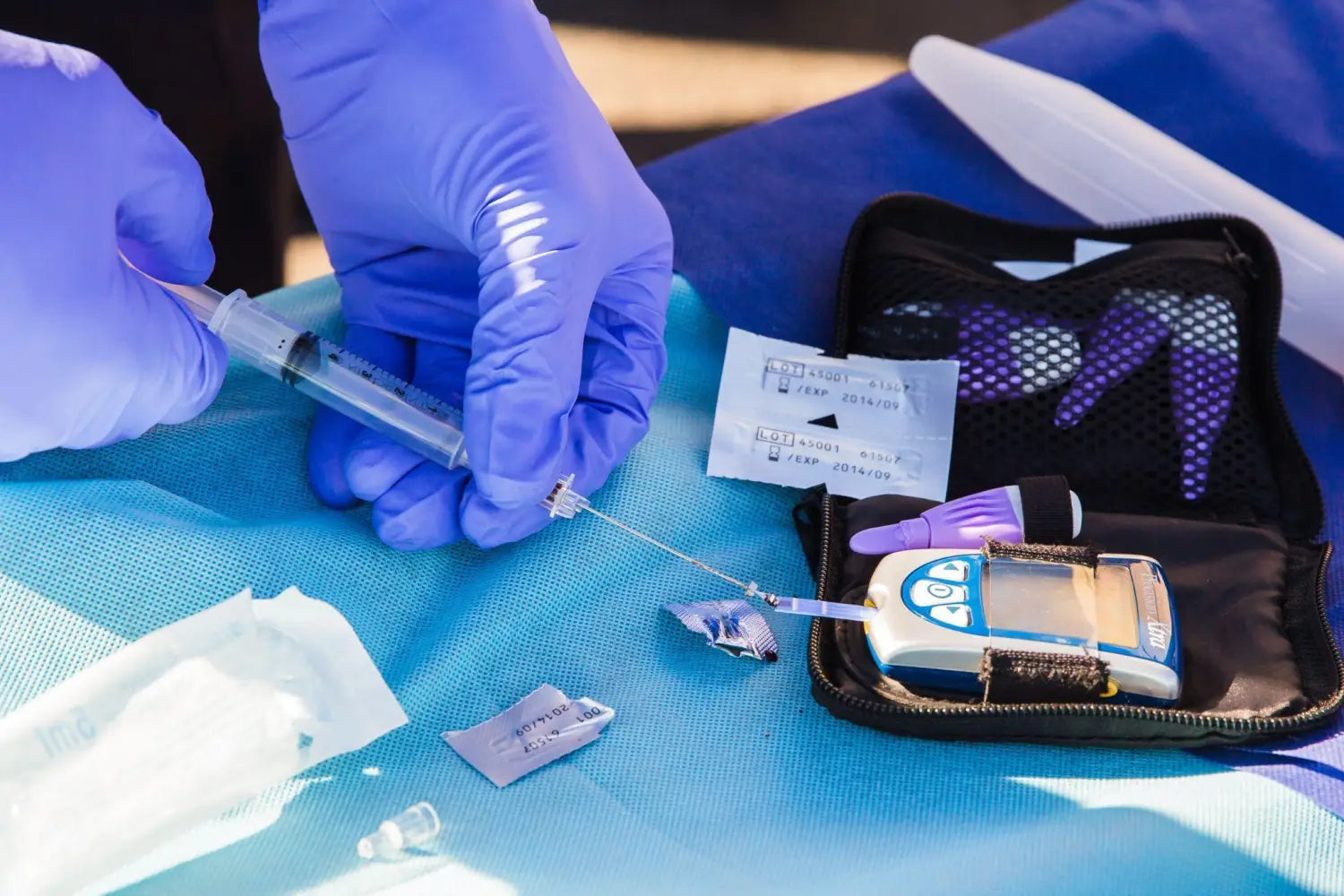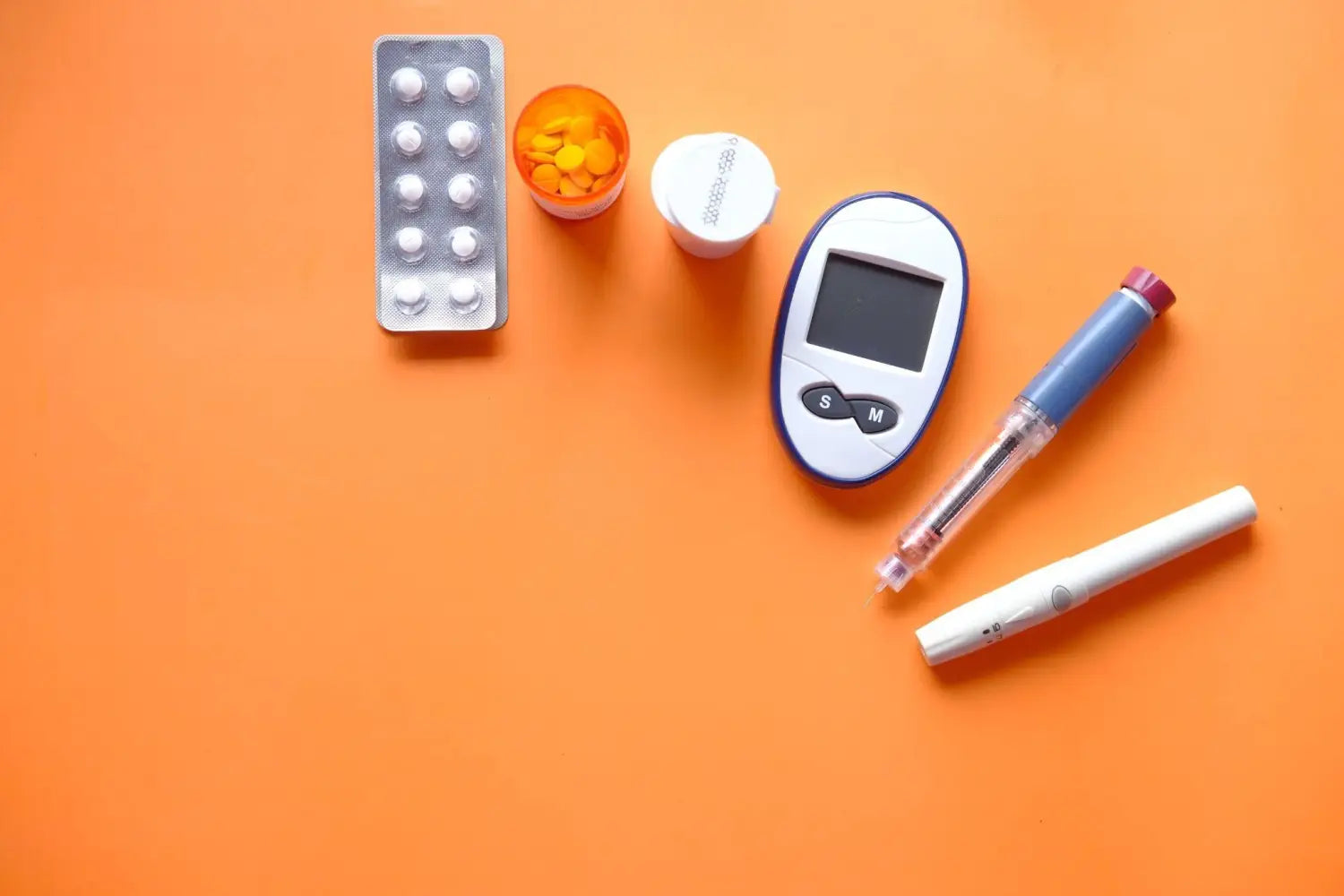
ALL THE INFO YOU NEED TO KNOW ABOUT DIABETES
What is Diabetes?
With diabetes, your body either doesn’t make enough insulin or can’t use it as well as it should.
Diabetes is a chronic (long-lasting) health condition that affects how your body turns food into energy.
BM10 may help your body deal with glycosuria, blood sugar, thirst, and negative feelings.
Most of the food you eat is broken down into sugar (also called glucose) and released into your bloodstream. When your blood sugar goes up, it signals your pancreas to release insulin. Insulin acts like a key to let the blood sugar into your body’s cells for use as energy.
If you have diabetes, your body either doesn’t make enough insulin or can’t use the insulin it makes as well as it should. When there isn’t enough insulin or cells stop responding to insulin, too much blood sugar stays in your bloodstream. Over time, that can cause serious health problems, such as heart disease, vision loss, and kidney disease.
There isn’t a cure yet for diabetes, but losing weight, eating healthy food, and being active can really help. Taking medicine as needed, getting diabetes self-management education and support, and keeping health care appointments can also reduce the impact of diabetes on your life.
What are the different types of diabetes?
The most common types of diabetes are type 1, type 2, and gestational diabetes.
Type 1 diabetes
If you have type 1 diabetes, your body does not make insulin. Your immune system attacks and destroys the cells in your pancreas that make insulin. Type 1 diabetes is usually diagnosed in children and young adults, although it can appear at any age. People with type 1 diabetes need to take insulin every day to stay alive.
Type 2 diabetes
If you have type 2 diabetes, your body does not make or use insulin well. You can develop type 2 diabetes at any age, even during childhood. However, this type of diabetes occurs most often in middle-aged and older people. Type 2 is the most common type of diabetes.
Gestational diabetes
Gestational diabetes develops in some women when they are pregnant. Most of the time, this type of diabetes goes away after the baby is born. However, if you’ve had gestational diabetes, you have a greater chance of developing type 2 diabetes later in life. Sometimes diabetes diagnosed during pregnancy is actually type 2 diabetes.
Other types of diabetes
Less common types include monogenic diabetes, which is an inherited form of diabetes, and cystic fibrosis-related diabetes.

Symptoms of diabetes
Diabetes symptoms are caused by rising blood sugar.General symptoms
The general symptoms of diabetes include:- increased hunger
- increased thirst
- weight loss
- frequent urination
- blurry vision
- extreme fatigue
- sores that don’t heal
Symptoms in men
In addition to the general symptoms of diabetes, men with diabetes may have a decreased sex drive, erectile dysfunction (ED), and poor muscle strength.Symptoms in women
Women with diabetes can also have symptoms such as urinary tract infections, yeast infections, and dry, itchy skin.
Type 1 diabetes
Symptoms of type 1 diabetes can include:- extreme hunger
- increased thirst
- unintentional weight loss
- frequent urination
- blurry vision
- tiredness
It may also result in mood changes.
Type 2 diabetes
Symptoms of type 2 diabetes can include:- increased hunger
- increased thirst
- increased urination
- blurry vision
- tiredness
- sores that are slow to heal
Gestational diabetes
Most women with gestational diabetes don’t have any symptoms. The condition is often detected during a routine blood sugar test or oral glucose tolerance test that is usually performed between the 24th and 28th weeks of gestation.In rare cases, a woman with gestational diabetes will also experience increased thirst or urination.

Calc Sulph may help with cellular regeneration, skin problems, blemishes, and slow-healing wounds. Effective natural therapy for discharge issues related to pimples, boils, ulcers & more.
Causes of diabetes
Different causes are associated with each type of diabetes.Type 1 diabetes
Doctors don’t know exactly what causes type 1 diabetes. For some reason, the immune system mistakenly attacks and destroys insulin-producing beta cells in the pancreas.Genes may play a role in some people. It’s also possible that a virus sets off the immune system attack.
Type 2 diabetes
Type 2 diabetes stems from a combination of genetics and lifestyle factors. Being overweight or obese increases your risk too. Carrying extra weight, especially in your belly, makes your cells more resistant to the effects of insulin on your blood sugar.
This condition runs in families. Family members share genes that make them more likely to get type 2 diabetes and to be overweight.
Gestational diabetes
Gestational diabetes is the result of hormonal changes during pregnancy. The placenta produces hormones that make a pregnant woman’s cells less sensitive to the effects of insulin. This can cause high blood sugar during pregnancy.
Women who are overweight when they get pregnant or who gain too much weight during their pregnancy are more likely to get gestational diabetes.
Risk factors
Certain factors increase your risk for diabetes.
Type 1 diabetes
You’re more likely to get type 1 diabetes if you’re a child or teenager, you have a parent or sibling with the condition, or you carry certain genes that are linked to the disease.Type 2 diabetes
Your risk for type 2 diabetes increases if you:- are overweight
- are age 45 or older
- have a parent or sibling with the condition
- aren’t physically active
- have had gestational diabetes
- have prediabetes
- have high blood pressure, high cholesterol, or high triglycerides
- have African American, Hispanic or Latino American, Alaska Native, Pacific Islander, American Indian, or Asian American ancestry
BM135 is best used for issues related to high cholesterol, including deposits of excess fatty substance that collect in the skin or eyelid tissues and nodules in tendons, hands, or feet.
Gestational diabetes
Your risk for gestational diabetes increases if you:- are overweight
- are over age 25
- had gestational diabetes during a past pregnancy
- have given birth to a baby weighing more than 9 pounds
- have a family history of type 2 diabetes
- have polycystic ovary syndrome (PCOS)

Prediabetes
Doctors refer to some people as having prediabetes or borderline diabetes when blood sugar is usually in the range of 100 to 125 milligrams per deciliter (mg/dL).Normal blood sugar levels sit between 70 and 99 mg/dL, whereas a person with diabetes will have a fasting blood sugar higher than 126 mg/dL.
The prediabetes level means that blood glucose is higher than usual but not so high as to constitute diabetes.
People with prediabetes are, however, at risk of developing type 2 diabetes, although they do not usually experience the symptoms of full diabetes.
The risk factors for prediabetes and type 2 diabetes are similar. They include:
- being overweight
- a family history of diabetes
- having a high-density lipoprotein (HDL) cholesterol level lower than 40 mg/dL or 50 mg/dL
- a history of high blood pressure
- having gestational diabetes or giving birth to a child with a birth weight of more than 9 pounds
- a history of polycystic ovary syndrome (PCOS)
- being of African-American, Native American, Latin American, or Asian-Pacific Islander descent
- being more than 45 years of age
- having a sedentary lifestyle
Diabetes complications
High blood sugar damages organs and tissues throughout your body. The higher your blood sugar is and the longer you live with it, the greater your risk for complications.Complications associated with diabetes include:
- heart disease, heart attack, and stroke
- neuropathy
- nephropathy
- retinopathy and vision loss
- hearing loss
- foot damage such as infections and sores that don’t heal
- skin conditions such as bacterial and fungal infections
- depression
- dementia
Gestational diabetes
Uncontrolled gestational diabetes can lead to problems that affect both the mother and baby. Complications affecting the baby can include:- premature birth
- higher-than-normal weight at birth
- increased risk for type 2 diabetes later in life
- low blood sugar
- jaundice
- stillbirth
The mother can develop complications such as high blood pressure (preeclampsia) or type 2 diabetes. She may also require cesarean delivery, commonly referred to as a C-section.
The mother’s risk of gestational diabetes in future pregnancies also increases.
BIO7 may aid your body in dealing with glucose. Also, it may help with excessive urination and pain in the calves, thirst, and sleeplessness. Support for kidney and nerve function.
Prevention
Simple lifestyle measures have been shown to be effective in preventing or delaying the onset of type 2 diabetes. To help prevent type 2 diabetes and its complications, people should:- achieve and maintain a healthy body weight;
- be physically active – doing at least 30 minutes of regular, moderate-intensity activity on most days. More activity is required for weight control;
- eat a healthy diet, avoiding sugar and saturated fats; and
- Avoid tobacco use – smoking increases the risk of diabetes and cardiovascular disease.
Exercise and diet tips
If a doctor diagnoses a person with type 2 diabetes, they will often recommend making lifestyle changes to support weight loss and overall health.A doctor may refer a person with diabetes or prediabetes to a nutritionist. A specialist can help a person with diabetes lead an active, balanced lifestyle and manage the condition.
Diagnosis and treatment
Early diagnosis can be accomplished through relatively inexpensive testing of blood sugar.Treatment of diabetes involves diet and physical activity along with lowering of blood glucose and the levels of other known risk factors that damage blood vessels. Tobacco use cessation is also important to avoid complications.
Interventions that are both cost-saving and feasible in low- and middle-income countries include:
- blood glucose control, particularly in type 1 diabetes. People with type 1 diabetes require insulin, people with type 2 diabetes can be treated with oral medication, but may also require insulin;
- blood pressure control; and
- foot care (patient self-care by maintaining foot hygiene; wearing appropriate footwear; seeking professional care for ulcer management; and regular examination of feet by health professionals).
- screening and treatment for retinopathy (which causes blindness);
- blood lipid control (to regulate cholesterol levels);
- screening for early signs of diabetes-related kidney disease and treatment.

Steps a person can take to embrace a lifestyle with diabetes include:
- Eating a diet high in fresh, nutritious foods, including whole grains, fruits, vegetables, lean proteins, low-fat dairy, and healthy fat sources, such as nuts.
- Avoiding high-sugar foods that provide empty calories, or calories that do not have other nutritional benefits, such as sweetened sodas, fried foods, and high-sugar desserts.
- Refraining from drinking excessive amounts of alcohol or keeping intake to less than one drink a day for women or two drinks a day for men.
- Engaging in at least 30 minutes of exercise a day on at least 5 days of the week, such as walking, aerobics, riding a bike, or swimming.
- Recognizing signs of low blood sugar when exercising, including dizziness, confusion, weakness, and profuse sweating.
Slow, steady weight loss goals are more likely to help a person retain long-term benefits.
Using insulin
People with type I diabetes and some people with type 2 diabetes may need to inject or inhale insulin to keep their blood sugar levels from becoming too high.
Various types of insulin are available, and most are grouped by how long their effect lasts. There are rapid, regular, intermediate, and long-acting insulins.
Some people will use a long-acting insulin injection to maintain consistently low blood sugar levels.
Some people may use short-acting insulin or a combination of insulin types. Whatever the type, a person will usually check their blood glucose levels using a fingerstick.
This method of checking blood sugar levels involves using a special, portable machine called a glucometer. A person with type I diabetes will then use the reading of their blood sugar level to determine how much insulin they need.
Self-monitoring is the only way a person can find out their blood sugar levels. Assuming the level from any physical symptoms that occur may be dangerous unless a person suspects extremely low glucose and thinks they need a rapid dose of glucose.
The discovery of insulin was fascinating and controversial.
Calc Sulph may help with cellular regeneration, skin problems, blemishes, and slow-healing wounds. Effective natural therapy for discharge issues related to pimples, boils, ulcers & more.
How much is too much?
Insulin helps people with diabetes live an active lifestyle. However, it can lead to serious side effects, especially if a person administers too much.
Excessive insulin can cause hypoglycemia, or extremely low blood sugar, and lead to nausea, sweating, and shaking.
It is essential that people measure insulin carefully and eat a consistent diet that balances blood sugar levels as much as possible.
Other medications
In addition to insulin, other types of medication are available that can help a person to manage their condition.
Metformin
For type 2 diabetes, a doctor may prescribe metformin in pill or liquid form.It contributes to:
- lowering blood sugar
- making insulin more effective
It can also help in weight loss. Having a healthy weight can reduce the impact of diabetes.
As well as diabetes, a person may also have other health risks, and they may need medication to control these. A doctor will advise the individual about their needs.
SGLT2 inhibitors and GLP-1 receptor agonists
In 2018, new guidelines also recommended prescribing additional drugs for people with:- atherosclerotic cardiovascular disease
- chronic kidney disease
These are sodium-glucose cotransporter 2 (SGLT2) inhibitors or glucagon-like peptide-1 (GLP-1) receptor agonists.
For those with atherosclerotic cardiovascular disease and a high risk of heart failure, the guidelines advise doctors to prescribe an SGLT2 inhibitor.
GLP-1 receptor agonists work by increasing the amount of insulin the body produces and decreasing the amount of glucose that enters the bloodstream. It is an injectable drug. People may use it with metformin or alone. Side effects include gastrointestinal problems, such as nausea and a loss of appetite.
SGLT2 inhibitors are a new type of drug for lowering blood glucose levels. They work separately from insulin, and they may be useful for people who are not ready to start using insulin. People can take it by mouth. Side effects include a higher risk of urinary and genital infections and ketoacidosis.

Home remedies for lowering blood sugar
Exercise regularly
Regular exercise can help you get to and maintain a moderate weight and increase insulin sensitivity.Increased insulin sensitivity means your cells are better able to use the available sugar in your bloodstream.
Exercise also helps your muscles use blood sugar for energy and muscle contraction.
Manage your carb intake
Your body breaks carbs down into sugars (mostly glucose), and then insulin helps your body use and store sugar for energy.
When you eat too many carbs or have insulin-function problems, this process fails, and blood glucose levels can rise.
Increase your fiber intake
Fiber slows carb digestion and sugar absorption. For these reasons, it promotes a more gradual rise in blood sugar levels.
Furthermore, the type of fiber you eat may play a role.
There are two kinds of fiber:
- insoluble
- soluble
While both are important, soluble fiber has explicitly been shown to improve blood sugar management.
Additionally, a high fiber diet can help better manage type 1 diabetes by improving the body’s ability to regulate blood sugar and reducing blood sugar lows.
Foods that are high in fiber include:
- vegetables
- fruits
- legumes
- whole grains
The recommended daily intake of fiber is about 25 grams for women and 38 grams for men. That’s about 14 grams for every 1,000 calories
BIO16 is recommended for nervous exhaustion, fatigue, or sleeplessness resulting from stress and anxiety. Natural support for your nervous system to help cope with everyday stress and negative events.
Drink water and stay hydrated
Drinking enough water may help you keep your blood sugar levels within healthy limits.
In addition to preventing dehydration, it helps your kidneys flush out the excess sugar through urine.
One observational study showed that those who drank more water had a lower risk for developing high blood sugar levels.
Drinking water regularly helps rehydrate the blood, lowers blood sugar levels, and could reduce diabetes risk
Implement portion control
Portion control helps regulate calorie intake and can help maintain a moderate weight.
Consequently, weight management promotes healthy blood sugar levels and has been shown to reduce the risk of developing type 2 diabetes.
Monitoring your serving sizes also helps reduce calorie intake and subsequent blood sugar spikes.
Here are some helpful tips for managing portion sizes:
- Measure and weigh portions.
- Use smaller plates.
- Avoid all-you-can-eat restaurants.
- Read food labels and check the serving sizes.
- Keep a food journal.
- Eat slowly.

Choose foods with a low glycemic index
The glycemic index measures how we absorb or digest foods, which affects the rate at which blood sugar levels rise.
Both the amount and type of carbs determine how a food affects blood sugar levels.
Eating low-glycemic-index foods has been shown to reduce blood sugar levels in those with diabetes.
Although the glycemic index of foods is important, the amount of carbs consumed also matters.
Foods with a low to moderate glycemic index include:
- bulgur
- barley
- yogurt
- oats
- beans
- lentils
- legumes
- wheat pasta
- non-starchy vegetables
Manage stress levels
Stress can affect your blood sugar levels.
Hormones such as glucagon and cortisol are secreted during stress. These hormones cause blood sugar levels to go up.
One study showed that exercise, relaxation, and meditation significantly reduced stress and lowered blood sugar levels for students
Monitor your blood sugar levels
“What gets measured gets managed.”
Measuring and monitoring blood glucose levels can also help you better manage your levels.
For example, keeping track helps you determine whether you need to make adjustments in meals or medications.
It will also help you find out how your body reacts to certain foods.
Try measuring your levels every day and keeping track of the numbers in a log.
Sleep Solution is best used to minimize the symptoms of insomnia. It may prevent nighttime behavioral problems and restore healthy and regular sleep patterns. Support for calmness to promote natural, peaceful sleep.
Get enough quality sleep
Getting enough sleep feels excellent and is necessary for good health.
Poor sleeping habits and a lack of rest can also affect blood sugar levels and insulin sensitivity.
They can increase appetite and promote weight gain.
Sleep deprivation decreases the release of growth hormones and increases cortisol levels. Both of these play an essential role in blood sugar management
Eat foods rich in chromium and magnesium
High blood sugar levels and diabetes have also been linked to micronutrient deficiencies.
Examples include deficiencies in the minerals chromium and magnesium.
Chromium is involved in carb and fat metabolism. It also helps regulate blood sugar levels. A lack of chromium may predispose you to carb intolerance.
However, the mechanisms behind this are not entirely known. Studies also report mixed findings.
Some studies of people with diabetes showed that chromium had benefits for long-term blood sugar management. However, the alternative has also been found.
Chromium-rich foods include:
- meats
- whole grain products
- fruit
- vegetables
- nuts
Magnesium has also been shown to benefit blood sugar levels, while magnesium deficiency has been linked to a higher risk of developing diabetes.
Studies have linked individuals with the highest magnesium intake with up to a 47% lower risk for developing type 2 diabetes.
However, if you already eat plenty of magnesium-rich foods, you probably will not benefit from supplements.
Magnesium-rich foods include:
- dark leafy greens
- squash and pumpkin seeds
- tuna
- whole grains
- dark chocolate
- bananas
- avocados
- beans
Try apple cider vinegar
Apple cider vinegar has many health benefits.
It promotes lower fasting blood sugar levels, possibly decreasing its production by the liver or increasing its use by cells.
Furthermore, studies show that vinegar significantly influences your body’s response to sugars and can help improve insulin sensitivity.
It may be mixed in a few ounces of water that you can drink before a high carb meal or be mixed in salad dressing.
However, it’s essential to talk with your doctor before taking apple cider vinegar if you’re already taking medications that lower blood sugar.

Experiment with cinnamon extract
Cinnamon is known to have many health benefits.
It’s been shown to improve insulin sensitivity by decreasing insulin resistance at the cellular level.
Studies show cinnamon can also lower blood sugar levels by up to 29%.
It slows the breakdown of carbs in the digestive tract, which moderates the rise in blood sugar after a meal.
However, there are risks involved if you take too much cinnamon.
Try berberine
Berberine is the active component of an herb used in traditional Chinese medicine, including treating diabetes.
Berberine has been shown to help lower blood sugar and enhance carb breakdown for energy.
What’s more, berberine may be as effective as some blood-sugar-lowering drugs. This makes it one of the most effective supplements for those with diabetes or prediabetes.
However, many of the mechanisms behind its effects are still unknown.
More high-quality studies are needed to determine its safety and effectiveness.
Additionally, it may have some side effects, such as:
- diarrhea
- constipation
- flatulence
- abdominal pain
Eat fenugreek seeds
Fenugreek seeds are a great source of soluble fiber, which can help manage blood sugar levels.Many studies have shown that fenugreek can effectively lower blood sugar in people with diabetes. It also helps reduce fasting glucose and improve glucose tolerance.
Although not that popular, fenugreek can be added to baked goods to help treat diabetes.
The recommended dose of fenugreek seeds is 2–5 grams per day, although this varies from study to study.
Maintain a Moderate Weight
It’s a no-brainer that maintaining a moderate weight will help improve your health and may help prevent future health problems.
Weight management also promotes healthy blood sugar levels and has been shown to help reduce your risk for developing diabetes.
Even a 7% reduction in body weight can decrease your risk for developing diabetes by up to 58%, and it seems to work even better than a common diabetes medication.
BM247 provides support for metabolic function. Work as an appetite suppressant that may help with weight loss. Best used for hunger control for food and sugar cravings.
Bottom line
Some types of diabetes — like type 1 — are caused by factors that are out of your control. Others — like type 2 — can be prevented with better food choices, increased activity, and weight loss.
Discuss potential diabetes risks with your doctor. If you’re at risk, have your blood sugar tested and follow your doctor’s advice for managing your blood sugar.










Leave a comment